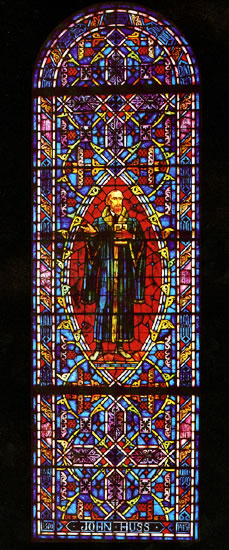
That same year, Huss attacked the clergy. As a result, he was deprived of his appointment as a synod preacher and was forbidden to exercise the priestly functions of the ministry. One of the great contributions that Huss made to the life of the church was his insistence that “the laymen take the cup” during the communion service. In spite of clerical opposition, Huss was a very popular figure and was again elected rector of the University of Prague in 1409.
Soon an inquisitor was appointed by the archbishop to inquire into charges of heresy that had been made against Huss. He was accused of speaking disrespectfully of the church, fermenting the quarrel between the Bohemians and the Germans, and speaking of Wycliffe as a pious and orthodox man.
In 1409, Pope Alexander V ordered the destruction of Wycliffe’s books and the excommunication of Huss and home of his friends from the church. Popular support for Huss made its protest known by sending a petition to Rome, asking that the condemnation be removed. However, in March 1411 the ban upon Huss was pronounced anew and ultimately the whole city of Prague was laid under interdict.
Huss continued preaching in the city and received a popular welcome wherever he went until the Council of Constance in 1415 when he was summoned to defend himself. It was impossible for him to make his defense because of the unwieldy mob at the trial, and the sentence of death was passed on him. He was burned at the stake the same day, July 6, 1415. His ashed and the soil on which they lay were thrown into the Rhine River. The influence of Huss lived on in Martin Luther and the reform movement in Germany.
The left side border symbols on the Huss window, numbered from top to bottom, are 1: a Latin cross, the type of cross upon which Christ was crucified, representing the effective love of God as revealed in the death of Christ for the salvation of mankind; 2. the Hand of God symbolizing his creative power, with the hand pointing downward from a cloud of glory, surrounded by a tri-radiant numbus signifying divinity; and 3. the shield of St. James the Greater with three scallion shells representing pilgrimages and journeys taken for missionary purposes.
The right side border symbols of the Huss window, numbered from top to bottom, are: 1. a lighted candle, representing Christ as the “Light of the World;” 2. the Ten Commandments symbolizing the commandments delivered by Moses in the Old Testament and man’s obligation to obey them and 3. an ankh representing hope in eternal life. In the early Christian church, the ancient Egyptian design was interpreted as a combination anchor and cross and used to conceal its true significance from spies and informers.














